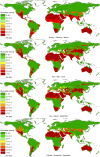Four billion people facing severe water scarcity - PubMed (original) (raw)
Four billion people facing severe water scarcity
Mesfin M Mekonnen et al. Sci Adv. 2016.
Abstract
Freshwater scarcity is increasingly perceived as a global systemic risk. Previous global water scarcity assessments, measuring water scarcity annually, have underestimated experienced water scarcity by failing to capture the seasonal fluctuations in water consumption and availability. We assess blue water scarcity globally at a high spatial resolution on a monthly basis. We find that two-thirds of the global population (4.0 billion people) live under conditions of severe water scarcity at least 1 month of the year. Nearly half of those people live in India and China. Half a billion people in the world face severe water scarcity all year round. Putting caps to water consumption by river basin, increasing water-use efficiencies, and better sharing of the limited freshwater resources will be key in reducing the threat posed by water scarcity on biodiversity and human welfare.
Keywords: envrionmnetal flow requirement; high spatial resolution; monthly water scarcity; water footprint.
Figures
Fig. 1. Quarterly averaged monthly blue water scarcity at 30 × 30 arc min resolution.
Water scarcity at the grid cell level is defined as the ratio of the blue water footprint within the grid cell to the sum of the blue water generated within the cell and the blue water inflow from upstream cells. Period: 1996–2005.
Fig. 2. Annual average monthly blue water scarcity at 30 × 30 arc min resolution.
Period: 1996–2005.
Fig. 3. The number of months per year in which blue water scarcity exceeds 1.0 at 30 × 30 arc min resolution.
Period: 1996–2005.
Similar articles
- Global monthly water scarcity: blue water footprints versus blue water availability.
Hoekstra AY, Mekonnen MM, Chapagain AK, Mathews RE, Richter BD. Hoekstra AY, et al. PLoS One. 2012;7(2):e32688. doi: 10.1371/journal.pone.0032688. Epub 2012 Feb 29. PLoS One. 2012. PMID: 22393438 Free PMC article. - Mapping Monthly Water Scarcity in Global Transboundary Basins at Country-Basin Mesh Based Spatial Resolution.
Degefu DM, Weijun H, Zaiyi L, Liang Y, Zhengwei H, Min A. Degefu DM, et al. Sci Rep. 2018 Feb 1;8(1):2144. doi: 10.1038/s41598-018-20032-w. Sci Rep. 2018. PMID: 29391421 Free PMC article. - Assessment of Water Footprints of Consumption and Production in Transboundary River Basins at Country-Basin Mesh-Based Spatial Resolution.
Wu X, Degefu DM, Yuan L, Liao Z, He W, An M, Zhang Z. Wu X, et al. Int J Environ Res Public Health. 2019 Feb 27;16(5):703. doi: 10.3390/ijerph16050703. Int J Environ Res Public Health. 2019. PMID: 30818781 Free PMC article. - Freshwater biodiversity: importance, threats, status and conservation challenges.
Dudgeon D, Arthington AH, Gessner MO, Kawabata Z, Knowler DJ, Lévêque C, Naiman RJ, Prieur-Richard AH, Soto D, Stiassny ML, Sullivan CA. Dudgeon D, et al. Biol Rev Camb Philos Soc. 2006 May;81(2):163-82. doi: 10.1017/S1464793105006950. Epub 2005 Dec 12. Biol Rev Camb Philos Soc. 2006. PMID: 16336747 Review. - Global hydrological cycles and world water resources.
Oki T, Kanae S. Oki T, et al. Science. 2006 Aug 25;313(5790):1068-72. doi: 10.1126/science.1128845. Science. 2006. PMID: 16931749 Review.
Cited by
- Global expansion of sustainable irrigation limited by water storage.
Schmitt RJP, Rosa L, Daily GC. Schmitt RJP, et al. Proc Natl Acad Sci U S A. 2022 Nov 22;119(47):e2214291119. doi: 10.1073/pnas.2214291119. Epub 2022 Nov 14. Proc Natl Acad Sci U S A. 2022. PMID: 36375068 Free PMC article. - Cost-Effective 3D-Printed Bionic Hydrogel Evaporator for Stable Solar Desalination.
Zhang S, Li M, Jiang C, Zhu D, Zhang Z. Zhang S, et al. Adv Sci (Weinh). 2024 May;11(17):e2308665. doi: 10.1002/advs.202308665. Epub 2024 Feb 11. Adv Sci (Weinh). 2024. PMID: 38342614 Free PMC article. - Combined use of municipal solid waste biochar and bacterial biosorbent synergistically decreases Cd(II) and Pb(II) concentration in edible tissue of forage maize irrigated with heavy metal-spiked water.
Abedinzadeh M, Etesami H, Alikhani HA, Shafiei S. Abedinzadeh M, et al. Heliyon. 2020 Aug 11;6(8):e04688. doi: 10.1016/j.heliyon.2020.e04688. eCollection 2020 Aug. Heliyon. 2020. PMID: 32817901 Free PMC article. - Constructing the Ecological Security Pattern of Nujiang Prefecture Based on the Framework of "Importance-Sensitivity-Connectivity".
Li Y, Zhao J, Yuan J, Ji P, Deng X, Yang Y. Li Y, et al. Int J Environ Res Public Health. 2022 Aug 31;19(17):10869. doi: 10.3390/ijerph191710869. Int J Environ Res Public Health. 2022. PMID: 36078587 Free PMC article. - Improving water efficiency is more effective in mitigating water stress than water transfer in Chinese cities.
Liu Y, Han B, Lu F, Gong C, Ouyang Z, Jiang CQ, Zhang X. Liu Y, et al. iScience. 2024 Feb 10;27(3):109195. doi: 10.1016/j.isci.2024.109195. eCollection 2024 Mar 15. iScience. 2024. PMID: 38420584 Free PMC article.
References
- World Economic Forum, Global Risks 2015, 10th Edition (World Economic Forum, Geneva, Switzerland, 2015).
- Vörösmarty C. J., Green P., Salisbury J., Lammers R. B., Global water resources: Vulnerability from climate change and population growth. Science 289, 284–288 (2000). - PubMed
- Ercin A. E., Hoekstra A. Y., Water footprint scenarios for 2050: A global analysis. Environ. Int. 64, 71–82 (2014). - PubMed
- Postel S. L., Daily G. C., Ehrlich P. R., Human appropriation of renewable fresh water. Science 271, 785–788 (1996).
- Savenije H. H. G., Water scarcity indicators; the deception of the numbers. Phys. Chem. Earth B 25, 199–204 (2000).
Publication types
MeSH terms
Substances
LinkOut - more resources
Full Text Sources
Other Literature Sources
Miscellaneous


